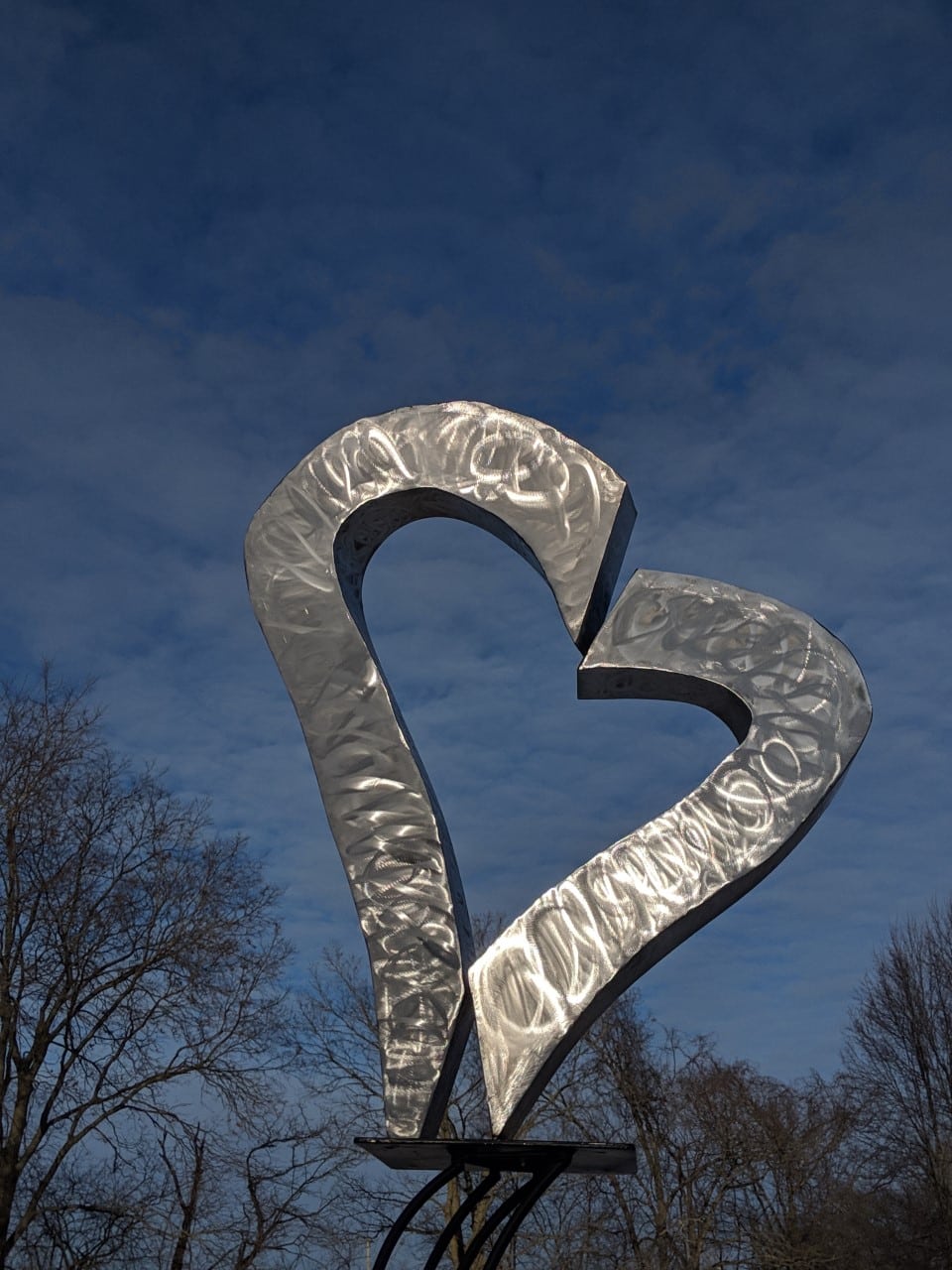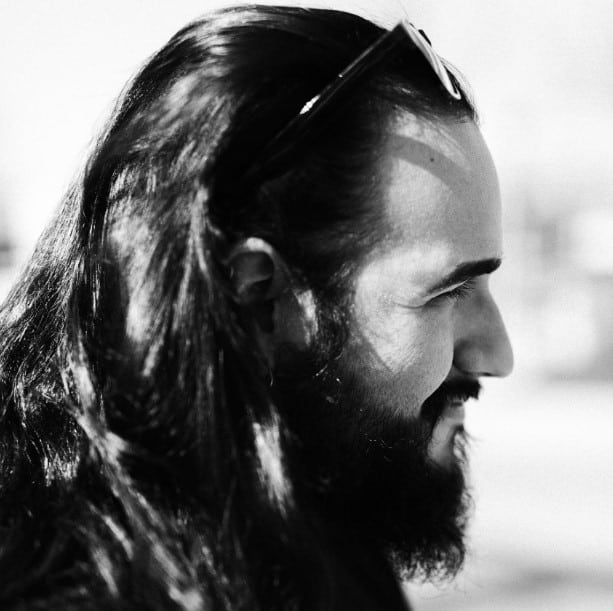On Friday, February 26th, downtown will see the installation of three new outdoor exhibits as part of the Macon Sculpture Walk. The work of Alex Mendez has been selected for display since the event’s inception by the Downtown Macon Community Association in 2018, but this year, the Indiana-based artist will be showcased exclusively with sculptures designed around the theme of Peace, Love, and Unity. Mendez’s previous offerings, like “Peace”, a massive, blue metal peace sign on permanent display at the corner of 2nd Street & Mulberry, have been welcome additions for locals and visitors alike while the artist himself has found a new home away from home in Central Georgia. “I fell in love with Macon two years ago when they did their first initial sculpture program,” Alex said during a recent call. “Macon was just so welcoming. And not only that but just so ready for the arts!” Speaking from his home in the Hoosier State (and after just shoveling snow), Alex shares details on his newest sculpture, welding to music, and the process of preparing his work for every element and eventuality.
AI- As I understand it, you started out helping your brother, Greg, install these very same kinds of public art pieces when you were just a teenager. Had you been into sculpture before that? Or any other visual medium?
AM- No, I actually, for the majority of my life, pretty much from the age of six to 24– I’m 30 now– I was a musician. A guitar player to be exact.
And that’s something you still do, correct?
Yes! I still noodle here and there. But for the majority of my life, I was a musician. I actually attended college for classical guitar performance. During my teenage years– 16 or so– Greg, my brother, started doing public sculpture. It was just him and a beat-up Chevy Silverado. So I would help him load and unload, and I did that for close to about 10 years. Finally, after a big trip out to Sioux Falls, South Dakota, on the drive back, I asked him if he would teach me how to weld. Come to find out, spending 10 years around not only my brother but other sculptors and just kind of sponging, I actually kinda knew what I was doing without realizing it!
That was a whole new calling, a whole new art form for you to start exploring. What was the first piece that you did that found its way into these wonderful public exhibits?
My first public sculpture was an abstract peacock feather, which from my current work, it’s come pretty far. That was pretty much made out of quarter-inch round rods, which is really not the type of steel I work with anymore. So from where I started to where I am now, they’re pretty much two different sculptors.

Anyone that’s seen your work would know that music is a big inspiration for you. What do you listen to when you’re sculpting? And does that come out in your work in unexpected ways?
Absolutely! It really depends on my mood. I could be listening to anything from classical guitar, like John Williams, to even Nine Inch Nails. Right now, I’m on a Foo Fighters kick because of their new album. And yeah, it does come out in unexpected ways. What happens a lot of times, the way I weld things, I don’t do continuous beads. I usually will weld an inch at a time or what have you. And so what’ll happen is I will catch myself welding to the rhythm of a song. So if you look at certain sculptures, the length of the weld, you can actually count it out to a rhythm. In fact, one of the sculptures I’m bringing to Macon, if you look at the welds, it’s one, two, three, four, one, two, three, four! I weld in a rhythm!
What’s that piece you’re talkin’ about. And what were you listenin’ to?
That piece will be called, uh, “Every Piece Has A Place”, and I was listening to Foo Fighters’ new album, Medicine at Midnight, which was just a really upbeat kind of pop rock. It shows in my welds what I was listening to.
So this is a fairly recent piece! Tell me about the other pieces coming in the installation. Can you share what those are?
I can really only share one of ’em. The other one we’re kind of working on, hopefully, bein’ a bit of a surprise. But “Every Piece Has A Place”, it’s been on my mind for probably about two years. You wouldn’t guess it from my appearance, but I’m pretty nerdy in all actuality. And so a lot of my sculptures are either music-related, they can be tied back to science fiction books, or even video games. “Every Piece Has A Place” was inspired by Tetris.
It’s got the Tetris shapes and what it is, it’s a window. The past two years have been rough nationally. For me, art, it’s your job to make people feel things. Whether it’s good emotions or bad emotions, it’s your job to elicit those. And with this, I was thinking everything is so divided, but we all fit together. We all mesh. When we work together, there really isn’t anything we can’t do. That was the concept for “Every Piece Has A Place” and that’s what I wanted to say. The funny thing was, it was driving me nuts! ‘Cause that’s what I wanted to say, and I had built myself into this box of knowing what I wanted to say, but I didn’t know how to say it! And finally, my significant other, Meredith, said, “You’re thinkin’ too hard, Alex! You’re a nerd. What thing do you love that can say that?” And it was like, “Oh, well, Tetris! Tetris is about unity!” And then I was off to the races after that!
Have you seen a greater demand for your work with the pandemic when it comes to these outdoor installations? It would seem that’s something people would be able to enjoy in a completely different aspect now that you really can’t be indoors and do things. When the spring rolled around, did you see an uptick in requests?
Yes and no. Yes, we did, both my brother and I, because it’s outdoors, it’s public. You can look at it and not be next to somebody. The problem was people wanted the artwork, but with the pandemic, we had a hard time getting places. I know that when all of this started back in March, it was hard for us to get through Illinois because Illinois was very locked down at the time. But we did see an increase of people wanting our artwork.
What are cities, organizations, businesses, what are they looking for when they contact you? Do they have like a standard request or do they say, “What would you suggest for us?” And second question to that, what’s been the wildest or strangest request you’ve ever received?
That’s kind of the beautiful thing about public sculpture programs like Macon. They don’t really make a request as to what they want. That’s the beauty of public sculpture programs is you get to enter your own work. It’s your own brainchild. Basically, it’s very validating when your sculptures get selected for a program because they’re your sculptures. They’re not a commission. They’re not somebody saying, “Hey, we want you to make this and we’ll display it.” No, it’s nothing like that. It’s you sitting in your shop going, “Oh, I want to make a 10-foot tree that I think would be seen in the Transformers movies!” And then you get to make it and display it! And it’s so validating to know that somebody somewhere looks at your sculpture and goes, “That’s pretty cool. Let’s display it!”
I don’t think I’ve ever really had any strange requests. The only thing people really ever request is that it’s safe for the public which is what you do anyways. I call it the 300-pound test, which is if I can stand on it, climb on it, nothing’s gonna happen to it at that point.

That brings me to another question, ’cause I wanted to ask you specifically about the installation. You make these things to be resilient in all weather from Indiana snow to Georgia sun, everything in between. There’s also the human element that I imagine you take into consideration. To be blunt, folks who may want to add their own little interpretations to your work– or, you know, drunks walking home from a night out or a show or something like that. What special considerations does that require when you’re building and installing these?
When you start with a design, you sketch it out in whatever program you use, and then you look at stress points. Like, “Okay, right here is a stress point,” and then you reinforce them. And then like you said, the human element, you have to sit in your shop after you completed it and painted it and you kind of have to go, “Okay, what would a drunk guy want to do?”
So you literally do consider that?
Yeah, you really do sit in your shop– and it’s usually after completion or halfway there– and go, “What would a drunk want to do?” And then you more or less pretend to be drunk and go, “Well, I would want to climb this, or I would want to stand here for a photo.” And then you start to go, “If they’re gonna stand here, I have to reinforce it here. I have to make sure I have an anchor bolt here.” Like I said, it’s the drunk test. You sit there and think, “What’s a drunk gonna wanna do?” And then you basically counteract it. You live by the idea of, if somebody really wants to damage it, they’re gonna damage it. They’re gonna find a way. No matter how well we make the paint, no matter how reinforced we make it, no matter how thick the metal is, if somebody wants to destroy it or be a jerk, they’re going to. That is part of the risk you run with public sculpture.
